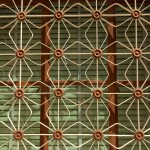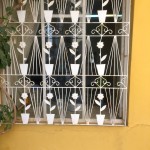You may recall we were about to embark on an overseas fieldtrip? Scran had the privilege of participating in the Archnetwork Erasmus+ course, Empowering Communities in Cyprus in September. Here’s the first instalment of our education officer’s report.
 Tuesday 15th September 2015. Our all-female, party of five had travelled from Scotland. The group consisted of heritage & education professionals with definite interests museum practice, interpretation, learning and community engagement. Although, through the week other interests & skills would surface as we got to know each other.
Tuesday 15th September 2015. Our all-female, party of five had travelled from Scotland. The group consisted of heritage & education professionals with definite interests museum practice, interpretation, learning and community engagement. Although, through the week other interests & skills would surface as we got to know each other.
Day one consisted of some orientation. For me, this was a first visit to Cyprus although others in the group had been before & we even had the privilege an ex-pat, Cypriot in our number. I purposely had not researched my destination in advance of my travels, so I was coming to the Kato Drys municipality uniformed & ready to learn. We were staying in the village of Pano Lefkara. 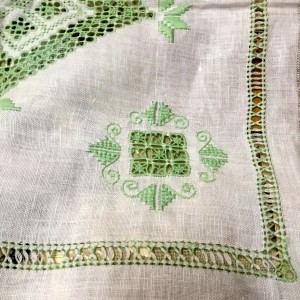 The village & surrounding area is renowned for it’s lace making, so much so, in 2009 it was recognised by UNESCO. Lefkara laces or Lefkaritika was added to the list of the UNESCO intangible cultural heritage . It also used to feature on a Cypriot bank note.
The village & surrounding area is renowned for it’s lace making, so much so, in 2009 it was recognised by UNESCO. Lefkara laces or Lefkaritika was added to the list of the UNESCO intangible cultural heritage . It also used to feature on a Cypriot bank note.
We set off on foot to explore the village with our host, Martin Clark. Just by our lodgings we started with some foraging – sampled fresh figs plucked from the tree, learned about the often, overlooked carob and picked a few almonds. The importance of these crops has been integral to the economy of Cyprus both past & present. Next we wondered towards the centre of the village to visit one of the many lace vendors, namely Harry & Maria Loizou’s shop.
 Here we were welcomed with some homemade traditional lemonade & shown a wealth of Lefkaritika as well as locally made silver jewellery. I had not seen the lace in reality before and there was no doubt that Lefkaritika was indeed beautiful. The pieces on offer were mostly traditional & could be considered old fashioned by some, however the lace is labour intensive to produce and requires years of skill to become a proficient maker. The lace makers of Lefkara are traditionally women, who learn the art from their mothers & grandmothers. Sadly this knowledge of applying cotton thread to linen is being lost as the population shifts away from Lefkara and other socio-economic pressures increase on Cypriot life.
Here we were welcomed with some homemade traditional lemonade & shown a wealth of Lefkaritika as well as locally made silver jewellery. I had not seen the lace in reality before and there was no doubt that Lefkaritika was indeed beautiful. The pieces on offer were mostly traditional & could be considered old fashioned by some, however the lace is labour intensive to produce and requires years of skill to become a proficient maker. The lace makers of Lefkara are traditionally women, who learn the art from their mothers & grandmothers. Sadly this knowledge of applying cotton thread to linen is being lost as the population shifts away from Lefkara and other socio-economic pressures increase on Cypriot life.
Loizou’s heavily stocked shop had an abundance of local hand crafted embroidery, which sat alongside a certain amount of imported mass-produced lace. This is testament to the financial straits the retailers of the village find themselves; in an attempt to offer cheaper products for the tourist market, it is however to the detriment of authentic, local lace making. This was not the only instance we would encounter such compromise, local high quality craft versus imported cheap mass production. The challenges of sustainable tourism were becoming obvious.

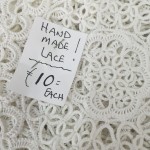
Following-on our walking tour, we proceeded to explore the narrow streets and admire the vernacular architecture. Did you know, the dimensions of the typical Cypriot house were originally dictated by the standard length of the local trees. I was especially interested to discover the significance of the colours adoring the homes around the village. Coming from Northern Ireland, I am all too aware of the power and impact of certain colour schemes. We were informed the homes with blue doors, shutters & window frames, were those of Greek Cypriots whereas the homes with green paintwork, were those of Turkish Cypriots, some of which were unoccupied. In the same vein, many doors had knockers in the shape of a woman’s hand. These would be referred to as the hand of Mary or the hand of Fatima depending on whether it was a Greek Cypriot Christian or Turkish Cypriot Muslim home respectively. Amongst the numerous Greek Orthodox churches in Lefkara we visited the impressive & ornate 14th Century Timios Stavros church. Further down the hill we also admired the derelict, but well maintained, mosque. It quickly became apparent to me that impact of history, politics and conflict was visible everywhere. As a visitor it was plain to see Lefkara is one village, with two distinct communities linked through many common threads.
aware of the power and impact of certain colour schemes. We were informed the homes with blue doors, shutters & window frames, were those of Greek Cypriots whereas the homes with green paintwork, were those of Turkish Cypriots, some of which were unoccupied. In the same vein, many doors had knockers in the shape of a woman’s hand. These would be referred to as the hand of Mary or the hand of Fatima depending on whether it was a Greek Cypriot Christian or Turkish Cypriot Muslim home respectively. Amongst the numerous Greek Orthodox churches in Lefkara we visited the impressive & ornate 14th Century Timios Stavros church. Further down the hill we also admired the derelict, but well maintained, mosque. It quickly became apparent to me that impact of history, politics and conflict was visible everywhere. As a visitor it was plain to see Lefkara is one village, with two distinct communities linked through many common threads.

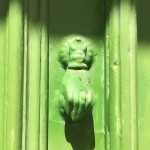

 Food brings people together, so later that day we had the pleasure of helping to make a batch of ketchup – this was a lot of fun. The glut of tomatoes had been harvested by a group of UK environmental conservation students on a course with Archnetwork’s, sister organisation Grampus. We also had a demonstration of preparing & preserving green olives for the coming months.
Food brings people together, so later that day we had the pleasure of helping to make a batch of ketchup – this was a lot of fun. The glut of tomatoes had been harvested by a group of UK environmental conservation students on a course with Archnetwork’s, sister organisation Grampus. We also had a demonstration of preparing & preserving green olives for the coming months. 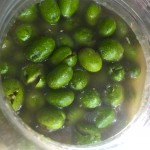 Our evening meal was prepared for us by our second host, Panayiota Demetriou local resident of the neighbouring village of Kato Drys. We observed the lighting of the customary Cyprus outdoor oven, a selection of dishes including tavas was put in & the domed oven was then sealed with clay for several hours of slow cooking. The results were delicious & served us well as a welcoming feast.
Our evening meal was prepared for us by our second host, Panayiota Demetriou local resident of the neighbouring village of Kato Drys. We observed the lighting of the customary Cyprus outdoor oven, a selection of dishes including tavas was put in & the domed oven was then sealed with clay for several hours of slow cooking. The results were delicious & served us well as a welcoming feast.
Imagery © J.Sangster


